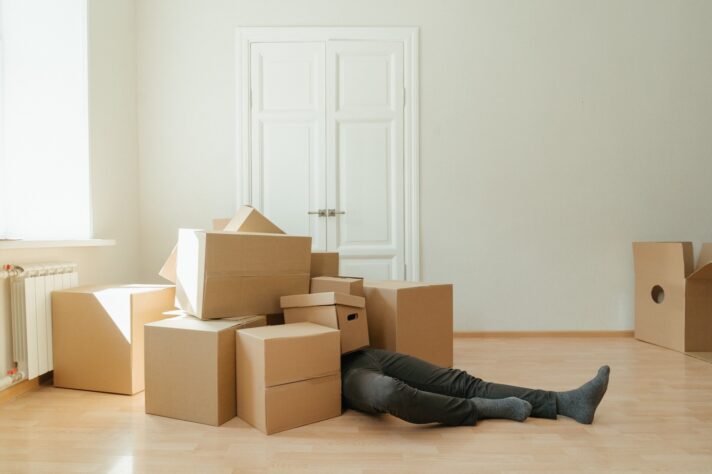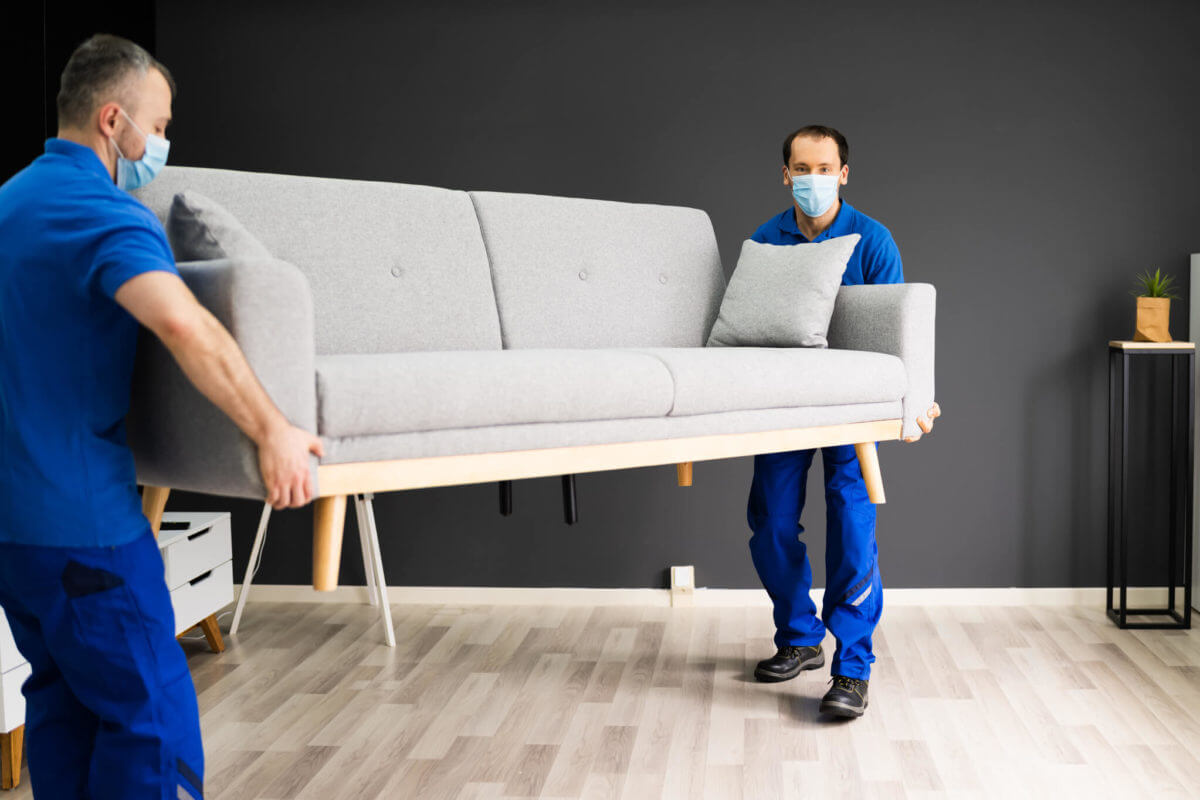Shipping a sofa across the country along with your other belongings can be a daunting task, but with the right approach, it can be done efficiently and safely. In this post, we’ll explore how to pack a sofa for moving, ensuring its protection during transit. From choosing the right materials to step-by-step instructions, we’ll cover all the essential tips and techniques for a smooth relocation.
How to wrap up your sofa for the upcoming relocation to a new home? Let's find out!
How to Pack a Sofa for Moving?
Packing a sofa for moving cross country requires careful planning and execution to ensure its safe transit. Begin by removing any detachable parts like cushions, legs, or slipcovers, and pack them separately in boxes or protective wraps. Next, thoroughly clean the sofa to prevent dirt and debris from damaging the upholstery during the move.
Once clean, wrap the pieces in furniture blankets or pads, securing them with packing tape, but avoid placing tape directly on the surface to prevent damage. For additional protection, wrap the furniture in stretch wrap, which helps keep the blankets in place and shields the item from moisture and dust.
The process of wrapping furniture items like sofas for a move can be complex
Start With Understanding Your Sofa’s Needs
Understanding your furniture’s unique characteristics is crucial for a successful relocation to a new home. Sofas come in various styles, such as sectional, sleeper, and loveseat, each with its specific packing needs. For example, sectional sofas, known for their multiple pieces, require disassembly before transport. Sleeper sofas, with their built-in mattresses, demand extra care when packing for a move. Loveseats, smaller than typical sofas, are easier to maneuver but still need safeguarding in order to be moved safely.
Material and structure are equally important. You especially need to pay attention to how to pack a leather sofa for moving, as these are prone to scratches and temperature damage. The structure, whether wood, metal, or composite, dictates the care during disassembly and packing. Keep in mind that fragile frames require additional padding, especially at stress points like corners and legs.
When it comes to furniture, different styles and materials require different treatment
The Preparation Stage – What to Do Before You Start Packing
There are several steps you’ll need to put on your to-do list before you’re ready to learn how to pack a sofa in a moving truck. Before the packing stage, a thorough cleaning is essential. This not only prevents dust and stains during the move to a new state but also preserves the furniture’s condition. Start by vacuuming the entire thing, using an upholstery attachment to reach deep into crevices.
Treat any existing stains with a suitable upholstery cleaner, following the manufacturer’s instructions. For leather sofas, use a leather conditioner to keep the material supple. Wipe down hard surfaces, like wooden or metal parts, with a damp cloth. Allow the furniture to air dry completely to prevent mold growth.
Disassembling Removable Parts Is Crucial
Disassembling your furniture is a critical step. Begin by removing all cushions and covers and packing them separately in moving boxes or plastic bags. Next, focus on detachable legs or feet. Turn the furniture over carefully and unscrew the legs, placing them in a labeled bag along with any screws and hardware. For sectionals, separate each component and wrap them individually.
Disassembling the furniture is a key part of the packing process
Gather All the Necessary Packing Materials
Ensuring you have the right packing materials is vital for safeguarding your belongings during a long-distance move. When choosing all the different types of materials, invest in high-quality options that will withstand the rigors of a long journey to another state. Good quality materials might cost more upfront but will provide better protection, reducing the risk of damage during the move. Here’s what you need to invest in when it comes to packaging your furniture:
- Stretch wrap is indispensable for protecting your furniture from dust, moisture, and scratches. Opt for a high-quality, thick stretch wrap that clings well and provides a secure shield around your items.
- Furniture blankets or pads are crucial for cushioning. They protect against bumps and scrapes that can occur in transit. Look for thick, durable blankets that cover the entire piece of furniture.
- Sofa covers, specifically designed for different types of sofas, offer another layer of protection. Choose covers that fit snugly and are made of breathable material, especially for leather sofas.
- Packing tape is needed to secure the blankets and wrap them in place. Use a strong, wide tape that sticks well but is also easy to remove without leaving residue.
- Bubble wrap provides additional cushioning for fragile parts like arms and legs. Select a bubble wrap with large bubbles for better protection.
- Cardboard can be used to create a protective barrier around the most vulnerable parts of the furniture, like the corners. Choose sturdy, corrugated cardboard for the best protection.
Let’s Go Through the Packing Process – Here’s a Step-By-Step Guide
Packing a sofa for relocation with long-distance movers is a meticulous process that requires attention to detail to ensure the item’s safety and integrity. The following steps outline how to efficiently pack this piece of furniture.
Step 1 – Wrapping the Sofa
Start by laying a furniture blanket flat on the ground and place the sofa on top of it. Wrap the blanket around its body, ensuring every part is covered, including the back, arms, and front. Secure the blanket with packing tape, but avoid sticking tape directly onto the surface.
For additional protection, wrap the entire piece of furniture in stretch wrap. This helps keep the furniture blanket in place and provides an extra layer of protection against dirt and moisture. Pay special attention to the arms and back, as these areas are prone to damage. If necessary, add extra layers of wrap or bubble wrap for cushioning.
Step 2 – Protecting the Frame
The frame of the sofa, especially if it’s made of wood or another fragile material, needs special attention. Use cardboard or additional bubble wrap to cover and protect corners and legs if you didn’t detach them from the sofa. This reduces the risk of chipping or breaking.
Step 3 – Securing Loose Components
Cushions, if they can’t be stored inside the sofa cover, should be wrapped separately in bubble wrap or placed in boxes. This prevents them from getting lost or damaged. For detachable legs or hardware, place them in a securely sealed bag. Label the bag clearly and attach it to the sofa or keep it in a designated “parts box” for easy reassembly later.
If you don't want to wrap furniture on your own, hire movers to do it for you
Should You Hire Professional Cross-Country Movers to Help You Transport Sofas and Other Furniture?
Deciding whether to hire cross-country movers for transporting sofas and other large items is a crucial consideration. The primary advantage of booking cross-country moving services lies in the movers’ expertise and experience in handling bulky, heavy items. Professional movers have the necessary equipment, such as furniture dollies and straps, to safely move large pieces, reducing the risk of damage.
Another significant benefit is the protection offered. Professional relocation companies typically provide insurance coverage for your items during transit. This means if your furniture is damaged or lost, you are entitled to compensation.
Additionally, moving furniture cross-country can be physically demanding and time-consuming. Professionals can save you significant effort and time, especially if you have other responsibilities, such as work or family. It’s particularly beneficial to hire professionals if you have valuable, antique, or specialty furniture. These fragile items often require specialized packing and handling to prevent damage.
What to Look for in a Long-Distance Moving Company?
When searching for a cross-country moving service, it’s important to evaluate several critical aspects. First and foremost, assess the reputation of the relocation company and customer reviews, which can provide insights into their reliability and quality of service. You can check reliable resources such as Better Business Bureau for this. It’s also essential to verify that the company is appropriately licensed for cross-country moves.
Experience in handling large furniture, like sofas, is a must, as this ensures that your items are moved efficiently. Transparent pricing is another key factor – a reputable company should provide a clear and detailed quote without hidden fees. Additionally, consider whether you need extra services, such as packing assistance or storage, and check if the company offers these. Finally, don’t overlook the importance of customer service – a responsive and helpful company can significantly ease the relocation stress.
Hire professional movers to make your relocation a smooth, stress-free process
Want to Move Effortlessly? Contact Cross Country Moving Company for Professional Assistance
Cross Country Moving Company offers professional assistance to make your relocation seamless and efficient. Specializing in long-distance moving services, our company prides itself on its ability to handle every aspect of your move with expertise and care. Using state-of-the-art equipment and techniques, we can guarantee the safety and security of your belongings throughout the journey.
We stand out among other cross-country moving companies thanks to our commitment to customer satisfaction, offering transparent pricing and personalized relocation plans. By choosing us, you’re not just transporting your items – you’re ensuring a smooth, stress-free transition to your new home. Contact us today to experience an effortless move!
FAQ
Can I Move a Large Sectional Sofa Across the Country Without Disassembling It?
Transporting a large sectional sofa across the country without disassembling it is feasible but not ideal. The primary challenge is the size and awkward shape, which can make maneuvering and fitting it into a truck difficult. If you choose not to disassemble it, ensure the truck is large enough and use furniture pads and stretch wrap for protection. However, disassembling it, if possible, would be safer and more space-efficient.
What Is the Best Way to Protect a Leather Sofa During a Long-Distance Move?
To protect a leather sofa during a long-distance move, use breathable furniture blankets to wrap it, followed by a layer of stretch wrap for additional protection. Avoid using plastic wrap directly on the leather, as it can trap moisture and cause damage. Instead, use the plastic wrap over the blankets to hold them in place. Also, consider using corner protectors to safeguard the edges and legs.
How Do I Secure a Sofa in a Moving Truck to Prevent Shifting?
To secure a sofa in a truck, place it upright against the truck’s wall. Use straps to fasten it to the truck’s tie-down points, ensuring it’s snug and immobile. If there’s extra space around the item, fill it with soft items like boxes or other padded materials to prevent shifting. Always balance the load in the truck for safe transport.
Are There Special Considerations for Packing a Sleeper Sofa?
Yes, sleeper sofas require special considerations for packing. Remove the mattress and pack it separately. Secure the metal frame and folding mechanism with sturdy straps or rope to prevent it from opening during transit. Wrap the sofa part with blankets and stretch wrap for protection, paying extra attention to protruding parts.
How Can I Protect My Sofa From Moisture and Humidity Changes During Transit?
To protect your sofa from moisture and humidity changes during transit, use silica gel packets and small, portable dehumidifiers in the truck. Ensure good ventilation if you’re using any plastic wrap. Additionally, make sure the truck is weather-proof and well-sealed against external elements.















